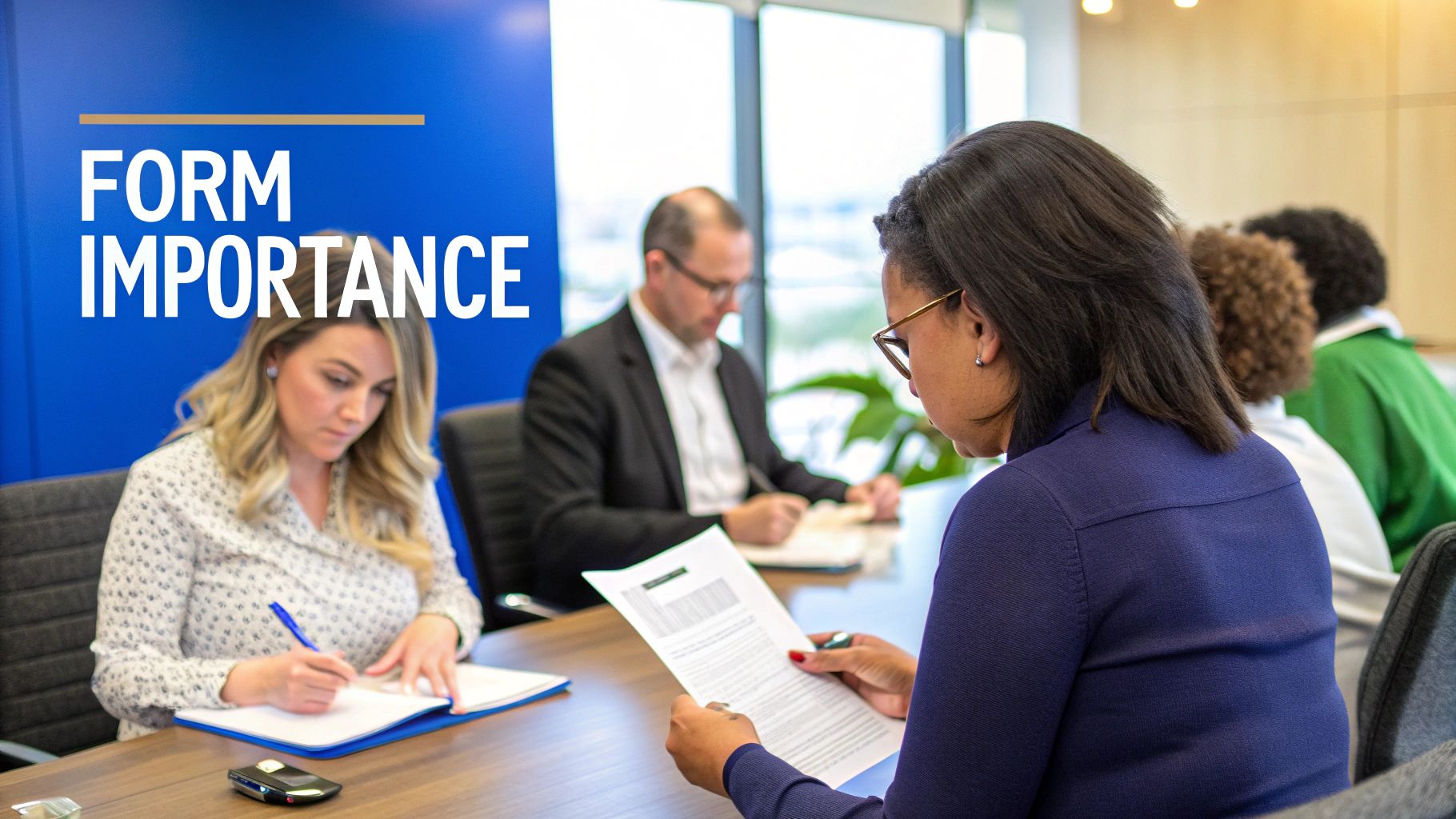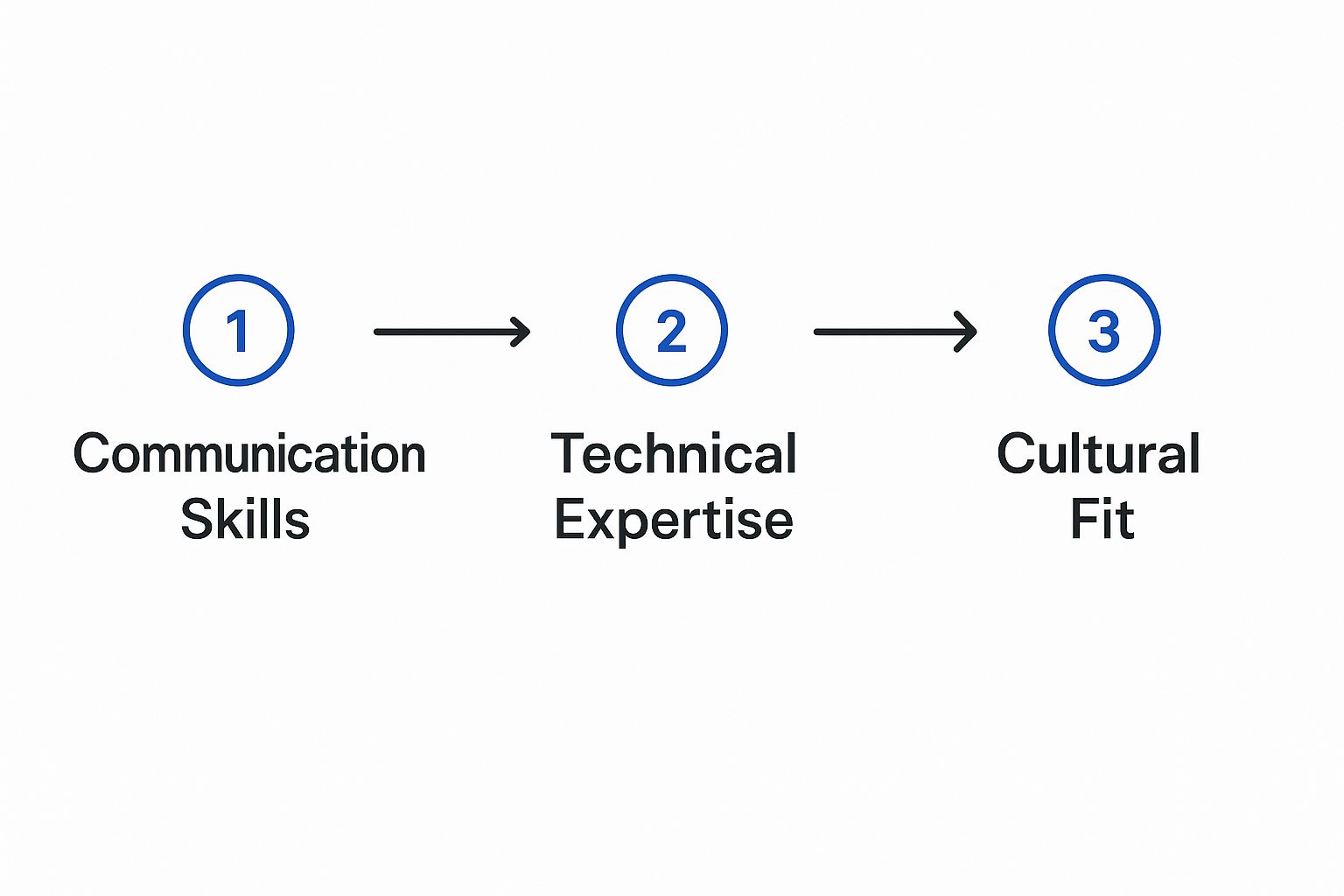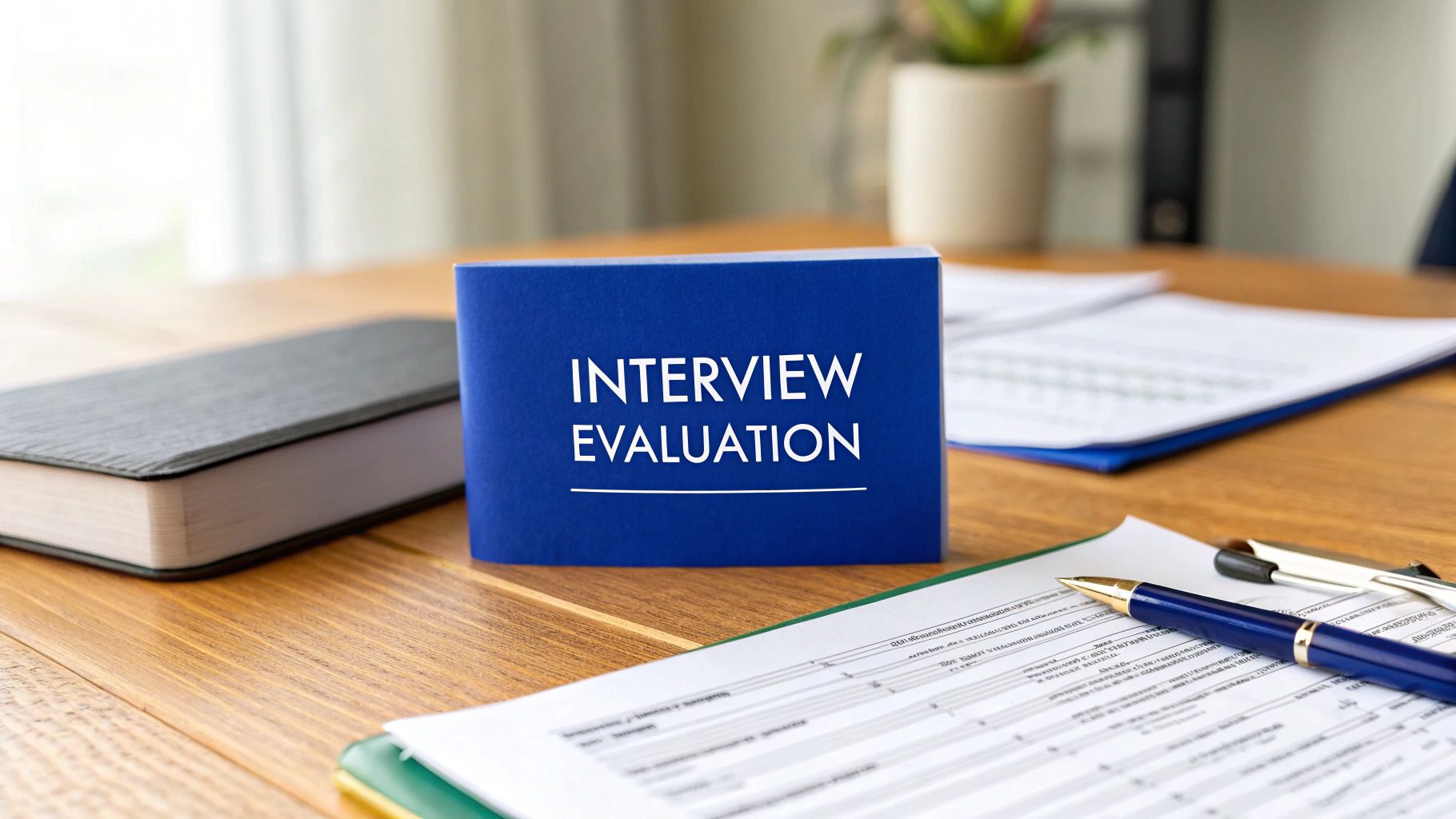An interview evaluation form is a structured document that hiring teams use to score candidates against a specific set of criteria. Think of it less as a form and more as a framework that transforms hiring from a subjective guessing game into an objective, data-driven decision-making exercise. It’s the best way to ensure every applicant gets a fair look.
Why Gut-Feeling Hires Fail and Data-Driven Decisions Win

Let’s be honest, relying on instinct or a "good feeling" about a candidate is a risky and outdated way to hire. Without a structured approach, interview feedback often becomes a messy jumble of personal opinions, heavily influenced by unconscious bias. One interviewer might praise a candidate’s confidence, while another sees it as arrogance. This sort of inconsistency makes it almost impossible to compare candidates on an equal footing.
An interview evaluation form brings much-needed consistency and objectivity to the table. By sitting down and defining the essential skills and competencies before the first interview, you make sure everyone on the hiring panel is looking for the same things. This standardised approach is your single best defence against bias creeping into your decisions.
Before we dive deeper, let’s look at a quick comparison. It really highlights the difference a structured process can make.
Gut Feeling vs Data-Driven Hiring
As you can see, the contrast is stark. One path is fraught with risk and inconsistency, while the other leads to fairer, more reliable outcomes.
The Legal and Compliance Edge
In the UK, where hiring processes are under close scrutiny, solid documentation is your best friend. A consistent, well-recorded assessment process creates a transparent and defensible record of every hiring decision you make. This is crucial for protecting your organisation, as it demonstrates that every candidate was evaluated against the same job-related criteria, helping to mitigate the risk of discrimination claims.
The numbers really drive this point home. With only about 2% of applicants even getting an interview and an average of six candidates interviewed for each role in the UK, the competition is fierce. A structured form is essential for systematically picking out the top talent from this small pool.
A well-designed interview evaluation form isn’t just about picking a winner. It’s about creating a fair, equitable, and legally sound process that lifts the quality of your entire organisation. It ensures your decisions are based on merit, not just a whim.
From Unconscious Bias to Conscious Choice
We all have them. Cognitive biases—like the halo effect, where one positive trait overshadows everything else, or affinity bias, where we favour people who remind us of ourselves—are the silent enemies of effective hiring. To truly make data-driven decisions and move past gut feelings, you have to learn how to beat cognitive bias in decision making.
This is where the evaluation form really proves its worth. It forces interviewers to back up their ratings with specific evidence and examples from the conversation. The discussion shifts from a vague "I liked them" to a concrete "They demonstrated strong problem-solving skills when they described X."
This subtle shift is fundamental to building a diverse, high-performing team and is a cornerstone of any solid pre-employment screening process. Ultimately, it leads to better hires, stronger teams, and a more equitable company culture.
Building the Blueprint for Your Evaluation Form
A great interview evaluation form doesn't just happen; it's carefully architected. Before you even draft your first question or think about scoring, you need to lay the groundwork. This blueprint is what turns a vague job description into a set of concrete, measurable criteria that ensures every candidate gets a fair and consistent assessment.
Let's start with the non-negotiables. Every form needs a space at the top for the basic administrative details. It might seem like simple admin, but getting this right creates a clean, professional record from the get-go.
- Candidate’s Full Name
- Specific Role Applied For
- Name of the Interviewer(s)
- Date and Time of the Interview
When you're juggling multiple vacancies and interviewing dozens of people, having this information clearly documented prevents any mix-ups down the line. It's the first step to an organised hiring process.
Translating Requirements into Observable Behaviours
With the logistics sorted, we can get to the heart of the matter. The real power of an evaluation form lies in its ability to translate the job description into specific, observable actions. Vague terms like "good communicator" or "team player" are too subjective and leave far too much room for bias. We need to do better.
Think about it this way: instead of a single line for "Communication Skills," break it down into what that actually looks like in practice.
- Does the candidate articulate their ideas clearly and concisely?
- Do they listen actively without jumping in to interrupt?
- Are they asking insightful, clarifying questions?
- Can they adapt their communication style to the person they're talking to?
This approach forces interviewers to hunt for tangible evidence, not just rely on a gut feeling. It’s the difference between saying, "I liked how they communicated," and, "They explained a complex technical project using a simple analogy, which showed me they can make complicated information accessible."
Structuring Your Evaluation Categories
A well-designed form needs clear sections for different competencies. This structure keeps the interviewer focused and helps you build a holistic picture of the candidate. The infographic below illustrates a logical flow for assessing these different areas.

This visual shows a natural progression, starting with fundamental soft skills, moving into the specific abilities needed for the job, and finishing with how they might align with the wider organisation.
An effective interview evaluation form is not a checklist to be rushed through. It is a strategic tool designed to guide a structured conversation, ensuring that every candidate is measured against the criteria that truly matter for success in the role.
For highly structured roles, like those in customer service, the criteria have to be exceptionally clear. If you're looking for inspiration, it can be really helpful to look at examples of call center evaluation forms. Seeing how they define excellence in communication and problem-solving can spark some great ideas for your own forms.
Finally, think about weighting each section based on what's most critical for the role. For a senior software engineer, you might decide the technical skills section is worth 60% of the total score, with soft skills at 30% and cultural contribution making up the final 10%. For a client-facing project manager, those numbers might be completely flipped. This kind of strategic weighting ensures your final hiring decision truly reflects the priorities of the job.
Creating a Scoring System That Is Fair and Consistent

Let's be honest, an interview evaluation form is only as good as its scoring system. Without a clear, objective way to rate candidates, you’ll find yourself right back where you started: relying on gut feelings and getting wildly inconsistent feedback from your team. What we’re trying to build here is a framework that everyone can use easily and, most importantly, fairly.
The first step is to ditch vague numerical scales. Think about it—a "4 out of 5" can mean completely different things to two different interviewers. One person's '4' might be another's '3'. Instead, we need to use descriptive anchors that clearly define what each level of performance actually looks like in practice.
Defining Your Rating Scale
A simple but effective rating scale gives you clear definitions for each point. This gets rid of the guesswork and makes interviewers back up their ratings with actual evidence from the conversation. A well-defined scale really is the cornerstone of a solid interview form.
For instance, you could try a structure like this:
- 1 - Needs Significant Development: The candidate couldn’t demonstrate the competency at all, or their answers were well below what’s expected.
- 2 - Meets Some Expectations: The candidate showed a basic grasp but struggled to give detailed examples or real depth.
- 3 - Meets All Expectations: The candidate successfully showed the competency with relevant examples and met the standard needed for the role.
- 4 - Exceeds Expectations: The candidate provided strong, compelling proof of this skill and demonstrated a level well beyond what the role requires.
By defining what "Meets All Expectations" actually means before interviews start, you create a shared benchmark for the entire hiring team. This approach is absolutely crucial for comparing candidates accurately and it ties directly into tracking key employee performance metrics once you’ve made a hire.
A scoring system isn't just about assigning numbers; it's about creating a shared language for your hiring team. When everyone agrees on what 'good' looks like, you eliminate ambiguity and make your debrief meetings far more productive.
In today's job market, this level of detail is non-negotiable. To give you an idea, recent UK recruitment data showed a competition ratio of 3.69 applicants per vacancy, with 6,273 applications flooding in for just 1,698 roles in one sector alone. When you’re dealing with that kind of volume, a standardised interview form becomes essential for reliably measuring and comparing candidates. You can discover more about the recruitment data here.
Identifying Red Flags and Non-Negotiables
Beyond the standard scoring, your form needs a way to flag critical issues or absolute dealbreakers. These are the non-negotiables that could immediately take a candidate out of the running, no matter how well they scored elsewhere.
These red flags should be directly linked to the core demands of the job or your company culture. Some classic examples might be:
- Making disparaging remarks about former colleagues or employers.
- A clear and obvious misalignment with your core company values.
- Failing to answer basic, foundational technical questions for a specialist position.
Putting a dedicated "Red Flag" checkbox or notes section on the form ensures these critical issues don't get lost in the shuffle. It forces a conversation about whether the candidate should even move forward, creating a vital safety net that helps you maintain a high standard for every single hire and keep your decisions legally sound.
How to Customise Your Form for Different Roles
Let's be honest: a generic, one-size-fits-all interview evaluation form is a recipe for a bad hire. You wouldn't use the same yardstick to measure a senior software developer and a junior marketing assistant, so why would you use the same form? To make your hiring process truly effective, you need to adapt your master template for specific roles and even different interview stages.
This isn't just about ticking boxes. It's about turning a simple administrative tool into a strategic asset that reflects the unique demands of every single position in your company.
Adapting for Different Job Families
The skills and qualities you're looking for will naturally shift depending on the department or "job family." While some core competencies, like communication, are pretty universal, how they're applied and how much they matter can vary dramatically.
Think about it this way. For a technical role—say, a programmer or data analyst—your form should be laser-focused on:
- Problem-Solving Abilities: Can they actually break down a complex technical problem and walk you through their thought process?
- Specific Technical Proficiency: Do they have genuine, hands-on experience with the languages, software, or platforms essential for the job?
- System Design and Architecture: For more senior folks, can they think bigger and design systems that are both scalable and reliable?
Now, pivot to a sales position. The evaluation form would look completely different, prioritising things like:
- Persuasion and Influence: How well do they build rapport and make a case that’s actually compelling?
- Resilience and Objection Handling: What happens when they face a bit of pushback? Do they stay positive or get flustered?
- Active Listening: Are they truly hearing the client's needs, or just waiting for their turn to talk?
This targeted approach stops you from trying to fit a square peg in a round hole. You're no longer judging a creative designer on their coding skills or a developer on their sales pitch.
Tailoring for Interview Stages
Just as the roles are different, so are the interviews themselves. An initial phone screen has a completely different purpose than a final, in-depth panel interview. Your evaluation form needs to evolve with the candidate's journey.
The phone screen is your first filter. It’s all about efficiency. The form for this stage should be short and sweet, zeroing in on the absolute essentials: core qualifications, salary expectations, and any immediate red flags. You’re really just asking, "Does this person meet the basic criteria and are they genuinely interested?"
An interview evaluation form is a living document. It should evolve not only from role to role but also from stage to stage within the hiring process, becoming more detailed as the candidate progresses.
By the time you get to the final interview, you're playing a different game. This is the deep dive. The form here needs to be far more comprehensive, designed to probe complex problem-solving skills, team dynamics, and long-term potential. This is where you bring in those heavily-weighted, role-specific competencies we talked about earlier.
It's also the perfect time to assess cultural alignment. You need to know how a candidate's values and working style will mesh with your team. To do this right, you can learn more about creating insightful cultural fit interview questions and integrate them directly into your final-stage form. This ensures your evaluation is holistic, covering both hard skills and team synergy.
Putting Your Form into Practice Successfully

You can design the most brilliant interview evaluation form in the world, but if it just sits in a folder, it’s all for nothing. The real magic happens when you bring it to life. This is where your thoughtful design translates into consistent, fair hiring decisions. Think of it less as rolling out a new rule and more as building a shared commitment across your entire hiring team.
The single most important part of this is training your interviewers. Firing off an email with the new template attached and crossing your fingers is a guaranteed way to fail. You need to actually sit down with them. Walk them through the form, explain the thinking behind each section, and make sure everyone is crystal clear on how the scoring works. When people understand the 'why,' they're far more likely to buy in and use it properly.
This training is also the perfect time to coach them on writing effective, bias-free feedback. Vague notes like "good vibe" or "not a culture fit" are useless at best and discriminatory at worst. We need to move beyond gut feelings.
Guide your team to capture specific, evidence-based observations.
- Instead of: "Seemed confident."
- Try this: "Clearly articulated their past project successes with specific metrics and took ownership of their role in the outcomes."
That small shift from subjective feelings to objective evidence is what makes a hiring process truly fair.
Managing Forms and Facilitating Debriefs
Okay, so your team is trained. What's next? You need a dead-simple, central place to keep all the completed forms. It doesn't have to be fancy—a dedicated Applicant Tracking System (ATS) is great, but a well-organised shared drive can work just fine. The key is consistency. Everyone on the team must know exactly where to find the forms and how to complete them every single time.
This organisation pays huge dividends in your post-interview debriefs. A proper debrief meeting shouldn’t be a freewheeling chat about who liked whom. The interview evaluation form becomes the anchor for the entire conversation, providing a common language and structure. Each interviewer can share their scores and, more importantly, the specific evidence from the interview that justifies those ratings.
An effective debrief meeting isn't about deciding who you 'liked' the most. It's a structured, evidence-based discussion where each interviewer uses the evaluation form to justify their ratings, ensuring the final decision is a collective, objective choice.
This simple structure is powerful. It stops the loudest person in the room from steering the decision and forces everyone to evaluate each candidate against the same criteria. It’s all about protecting the integrity of the process.
Think about the sheer volume of interviews happening. The UK Labour Force Survey, for instance, reported interviews with 58,680 individuals in just one quarter. When you're dealing with numbers on that scale, you can see why a consistent interview evaluation form is absolutely essential for collecting reliable data. You can find more on the survey's scale and methodology on the ONS website.
By prioritising proper training, straightforward logistics, and structured debriefs, you ensure your form becomes a cornerstone of your hiring strategy, not just another piece of administrative fluff.
Common Questions About Interview Evaluation Forms
Even with the best-designed evaluation form, questions are bound to pop up once your team starts using it in the real world. Let's tackle some of the most frequent ones I hear from hiring managers. Getting these answers straight from the start will help everyone feel more confident and keep your process fair and consistent.
How Do We Prevent Bias Creeping into Our New Forms?
This is a big one, and rightly so. A form is just a tool; its power to reduce bias depends entirely on how it’s used. The single most effective thing you can do is proper training. Before you roll out any new interview evaluation form, you need to hold a session with your interviewers. Walk them through the why behind each section and explain what each point on your scoring scale actually looks like in practice.
You should also enforce a strict "evidence-only" policy for all written notes. This is crucial. It means training interviewers to document what a candidate said or did, not how they made the interviewer feel.
For example, instead of writing "Not confident," a better note would be, "Avoided eye contact and did not provide specific examples when asked about past project challenges." This small change shifts the focus from a gut feeling to an observable behaviour.
The real purpose of an interview evaluation form is to guide an objective discussion, not just to collect scores. It forces a conversation based on evidence, which is your most powerful defence against unconscious bias. Regularly reviewing completed forms as a team is a great way to calibrate everyone and spot potential issues early.
What Is the Best Way to Use the Form During a Video Interview?
Video interviews add another layer of complexity. Trying to manage a video feed, build rapport, and take good notes all at once can be a real juggle.
The key here is preparation. If you can, have the digital form open in a separate window or, even better, use a second monitor. I always tell the candidate at the start of the call, "Just so you know, I'll be taking some notes on my screen to make sure I capture everything accurately." This simple bit of transparency stops them from thinking you're distracted or checking your email.
During the conversation, focus on jotting down key phrases and bits of evidence. Then, block out five minutes immediately after the call ends to flesh out your notes and finalise your scores while it’s all still fresh in your mind.
Should We Ever Share Evaluation Scores with Candidates?
As a general rule, no. The raw scores and internal comments on an interview evaluation form are designed for your team’s internal decision-making. They don't have the necessary context for a candidate and could easily be misinterpreted, which can lead to confusion or even disputes.
That said, you should absolutely use the detailed notes from the form to give constructive, specific feedback to unsuccessful candidates—if that’s part of your company policy. It’s a sign of respect for the time they invested and can do wonders for your employer brand.
How Often Should We Review and Update Our Forms?
Your business changes, and so do the roles within it. Your evaluation forms need to keep up.
I recommend planning a formal review of your interview evaluation forms at least once a year. You should also revisit them any time a role undergoes significant changes. This ensures the skills and competencies you're assessing are still relevant and perfectly aligned with where your organisation is heading.

